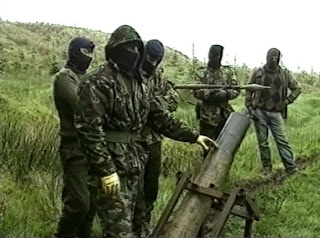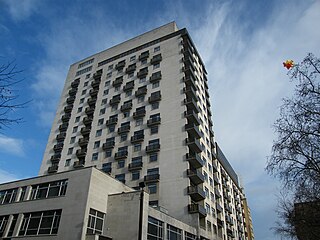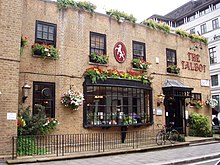
The Irish People's Liberation Organisation was a small Irish socialist republican paramilitary organisation formed in 1986 by disaffected and expelled members of the Irish National Liberation Army (INLA), whose factions coalesced in the aftermath of the supergrass trials. It developed a reputation for intra-republican and sectarian violence as well as criminality, before being forcibly disbanded by the Provisional Irish Republican Army (IRA) in 1992.
The Guildford pub bombings occurred on 5 October 1974 when the Provisional Irish Republican Army (IRA) detonated two 6-pound (2.7-kilogram) gelignite bombs at two pubs in Guildford, Surrey, England. The pubs were targeted because they were popular with British Army personnel stationed at Pirbright barracks. Four soldiers and one civilian were killed. Sixty-five people were wounded.

From 1969 until 1997, the Provisional Irish Republican Army (IRA) conducted an armed paramilitary campaign primarily in Northern Ireland and England, aimed at ending British rule in Northern Ireland in order to create a united Ireland.
Roger Philip Goad, was an explosives officer with London's Metropolitan Police Service who was posthumously awarded the George Cross for the heroism he displayed on 29 August 1975. He had previously been awarded the British Empire Medal in 1958 for gallantry whilst serving with the Royal Army Ordnance Corps in Cyprus, for repeated acts of deliberate courage in the disarming of bombs and booby traps set by terrorists.

The Balcombe Street siege was an incident involving members of the Provisional Irish Republican Army (IRA) and London's Metropolitan Police lasting from 6 to 12 December 1975. The siege ended with the surrender of the four IRA members and the release of their two hostages. The events were televised and watched by millions.

The 1973 Old Bailey bombing was a car bomb attack carried out by the Provisional IRA (IRA) which took place outside the Old Bailey Courthouse on 8 March 1973. The attack was carried out by an 11-person active service unit (ASU) from the Provisional IRA Belfast Brigade. The unit also exploded a second bomb which went off outside the Ministry of Agriculture near Whitehall in London at around the same time the bomb at the Old Bailey went off.

On 27 August 1975 a Provisional Irish Republican Army bomb exploded without warning at the Caterham Arms public house in Caterham, Surrey, England. There were no fatalities, but 33 people were injured, some severely, including three off-duty soldiers who lost limbs.
On Tuesday evening 18 November 1975 an Irish Republican Army (IRA) unit nicknamed the Balcombe Street Gang, without warning, threw a bomb into Walton's Restaurant in Walton Street, Knightsbridge, London, killing two people and injuring almost two dozen others.
The 1994 Heathrow mortar attacks were a series of homemade mortar bomb attacks targeted at Heathrow Airport carried out by the Provisional IRA. Over a five-day period, Heathrow was targeted three times by the IRA, which fired 12 mortar rounds. Heathrow was a symbolic target due to its importance to the United Kingdom's economy, and much disruption was caused when areas of the airport were closed over the period due to the IRA attacks. The gravity of the incident was heightened by the fact that Queen Elizabeth II was being flown back to Heathrow by the RAF on 10 March.

On Thursday 9 October 1975, a bomb attack just outside Green Park Underground station in the City of Westminster, London, left one man dead and injured 20 others. The attack was carried out by volunteers from the Provisional IRA's Balcombe Street Gang. The attack occurred during a period of heightened activity by the IRA in England and in particular London and surrounding areas, since the Caterham Arms pub bombing two months earlier in August 1975.
The Balcombe Street Gang was a Provisional Irish Republican Army (IRA) active service unit (ASU) who carried out a bombing campaign in southern England in the mid-1970s. The majority of their attacks and attempted attacks took place in London and the rest in Surrey, Hampshire and Wiltshire. Between October 1974 and December 1975 they carried out approximately 40 bomb and gun attacks in and around London, sometimes attacking the same targets twice. The unit would sometimes carry out two or more attacks in one day; on 27 January 1975 they placed seven time bombs in London.
On 17 June 1974 the Provisional IRA bombed the British Houses of Parliament causing extensive damage and injuring eleven people.

On 18 February 1991 two Provisional Irish Republican Army (IRA) bombs exploded at London mainline stations, one at Victoria station and the other at Paddington station, killing one person and injuring 38 other people at Victoria station. It was the IRA's second major attack in London in February 1991 after the Downing Street mortar attack eleven days earlier which was an attempt to assassinate the British War cabinet and the British prime minister John Major. It was also the first IRA attack against a civilian target in England since the 1983 Harrods bombing, marking a strategic change in their bombing campaign in England.
On 25 and 27 November 1974 the Provisional Irish Republican Army (IRA) placed several bombs in pillar boxes and one in a hedge behind a pillar box. This was a new tactic used by the IRA in England, although a similar tactic had been used in Northern Ireland during The Troubles several times previously. 40 people were wounded from five explosions in several districts.
The following is a timeline of actions during The Troubles which took place in the Republic of Ireland between 1969 and 1998. It includes Ulster Volunteer Force bombings such as the Dublin and Monaghan bombings in May 1974, and other Loyalist bombings carried out in the 1970s, 80s & 90s, the last of which was in 1997. These attacks killed dozens of people and injured hundreds more. Also actions carried out by Irish Republicans including bombings, prison escapes, kidnappings, and gun battles between the Gardaí (police) and the Irish Defence Forces against Republican gunmen from the Irish National Liberation Army, the Provisional Irish Republican Army, and a socialist-revolutionary group, Saor Éire. These attacks killed a number of civilians, police, soldiers, and Republican paramilitaries.
This is a timeline of the events and actions during the Troubles that were carried out in Great Britain, the vast majority of which were carried out by Irish Republican paramilitaries mainly the Provisional IRA were by far the most active but both the Official IRA and the Irish National Liberation Army, also carried out a number of attacks, which included bombings and shootings. Ulster Loyalist paramilitary groups also carried out a small number of violent actions.

On 19 January 1975 the Provisional IRA's Balcombe Street Gang opened fire with automatic weapons on two hotels in London, England. Twelve people were injured by broken glass. The IRA carried out a similar attack a month before, and attacked one of the hotels again a few months after.
A pub bombing or a public house bombing is an attack on a pub or public house using explosives and other bombing making material like nails, bolts, screws and similar objects which can cause horrific injuries when the bomb detonates. The Provisional IRA's Balcombe Street Gang used bolts and screws in many of their bomb attacks in the mid-1970s. Neo-nazi David Copeland used nails in his bombs.

The Woolwich pub bombing was an attack by the Provisional Irish Republican Army on the Kings Arms, Woolwich on the south bank of the Thames in London, United Kingdom.









